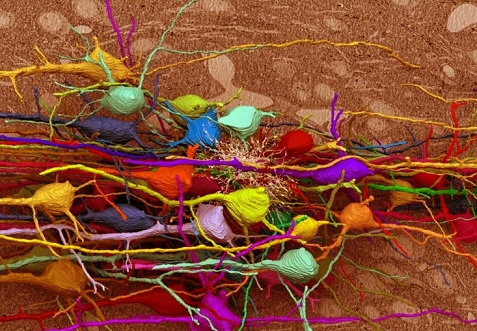Nikhil Prasad Fact checked by:Thailand Medical News Team Feb 02, 2025 10 months, 3 days, 5 hours, 21 minutes ago
Medical News:
Understanding the Link Between Small Fiber Neuropathy and Long COVID and Chronic Fatigue Syndrome
A recent study by researchers from multiple institutions in Spain has revealed crucial insights into the neurological complications associated with post-COVID condition (PCC) and Myalgic Encephalomyelitis/Chronic Fatigue Syndrome (ME/CFS). These conditions, known for causing persistent fatigue, cognitive impairments, muscle pain, and other debilitating symptoms, have now been linked to a specific form of nerve damage known as small fiber neuropathy (SFN). The study was conducted by scientists from the Neurodegenerative Diseases Group at Biobizkaia Health Research Institute, the Department of Neurology at Cruces University Hospital, the Biomedical Engineering Department at Mondragon Unibertsitatea, and the Department of Neurosciences at the University of the Basque Country, among other institutions.
 Small Fiber Neuropathy in Long COVID and Chronic Fatigue Syndrome
Small Fiber Neuropathy in Long COVID and Chronic Fatigue Syndrome
This
Medical News report delves into the study’s key findings, which highlight significant nerve impairments in patients suffering from these conditions. The researchers employed a variety of advanced diagnostic techniques to assess small fiber nerve function, including electrochemical skin conductance tests, corneal confocal microscopy, and sensory nerve evaluations. Their results indicate that patients with PCC and ME/CFS show notable nerve dysfunctions, which may be contributing to their chronic symptoms.
What is Small Fiber Neuropathy?
Small fiber neuropathy is a type of nerve damage that affects the tiny unmyelinated or minimally myelinated nerve fibers responsible for transmitting pain, temperature sensations, and autonomic functions such as blood pressure regulation and sweating. When these nerves are damaged, individuals can experience a wide range of symptoms, including burning pain, tingling, numbness, dizziness, abnormal sweating, and gastrointestinal disturbances.
This study focused on identifying whether SFN is present in individuals with PCC and ME/CFS and whether it contributes to their symptoms. Previous research has suggested that SFN may play a role in these conditions, but comprehensive data had been lacking.
Study Methodology and Patient Groups
The research team analyzed 90 individuals, divided into three groups: 30 PCC patients, 30 ME/CFS patients, and 30 healthy control subjects. Participants were matched by age and gender to ensure balanced comparisons. Each participant underwent multiple tests to assess their nerve function.
The assessments included:
-Electrochemical Skin Conductance Tests (Sudoscan) - to measure nerve responses in the hands and feet.
-In Vivo Corneal Confocal Microscopy (IVCCM) - a technique used to examine the small nerves in the cornea for signs of damage.
-Quantitative Sensory Testing (QST) - to determine temperature sensation thresholds.
-Autonomic Function Tests - includ
ing heart rate variability analysis and tilt-table testing to assess nervous system control over cardiovascular responses.
Key Findings: Evidence of Nerve Damage
The study found significant differences between the PCC and ME/CFS groups compared to healthy controls. The key findings include:
-Increased Small Fiber Nerve Dysfunction: Both PCC and ME/CFS patients exhibited impaired heat detection compared to healthy individuals, indicating sensory nerve dysfunction.
-Altered Corneal Nerve Structure: Patients with PCC and ME/CFS had increased tortuosity (irregular twisting) of small corneal nerve fibers. This suggests that their nerves are undergoing structural changes, possibly due to chronic inflammation or immune dysfunction.
-Autonomic Nervous System Impairments: Many patients in both groups displayed symptoms of autonomic dysfunction, such as dizziness upon standing, irregular heart rate, and abnormal sweating patterns. These symptoms were also reflected in physiological tests.
-Fatigue and Neuropathic Symptoms Correlation: Patients who exhibited higher levels of fatigue also tended to show more severe small fiber neuropathy symptoms, supporting the idea that nerve dysfunction could be a major factor in their chronic exhaustion.
What Do These Findings Mean for Patients?
The study provides compelling evidence that small fiber neuropathy is a significant factor in the development of symptoms in PCC and ME/CFS. The identification of SFN in these patients offers a potential explanation for many of their symptoms, including chronic pain, dizziness, and cognitive issues.
Furthermore, the research emphasizes the importance of a multimodal diagnostic approach. Traditional tests such as skin biopsies remain valuable, but newer, less invasive techniques like corneal confocal microscopy and electrochemical skin conductance testing can provide additional insights into nerve health.
Implications for Future Research and Treatment
One of the most crucial aspects of this study is its potential implications for treatment. If SFN plays a central role in the symptoms of PCC and ME/CFS, treatments aimed at nerve repair and function improvement could be beneficial. Possible treatment avenues include:
-
Immunomodulatory Therapies: Given that SFN may have an immune-related component, treatments targeting immune dysfunction could help alleviate symptoms.
-Neuropathic Pain Management: Medications such as gabapentinoids and serotonin-norepinephrine reuptake inhibitors (SNRIs) could help manage nerve pain.
-Autonomic Nervous System Support: Techniques such as fluid intake optimization, compression garments, and specific physical therapies may aid patients experiencing autonomic dysfunction.
-Regenerative Medicine: Investigating therapies that promote nerve repair and regrowth could be a promising area for future research.
Conclusion
This study sheds light on the underlying neurological issues faced by individuals with post-COVID condition and Myalgic Encephalomyelitis/Chronic Fatigue Syndrome. By identifying small fiber neuropathy as a key player in these conditions, researchers have paved the way for better diagnostic tools and targeted treatments. While much work remains to be done, these findings provide hope for millions suffering from these debilitating illnesses.
The study findings were published in the peer-reviewed journal: European Journal of Neurology.
https://onlinelibrary.wiley.com/doi/10.1111/ene.70016
For the latest COVID-19 News, keep on logging to Thailand
Medical News.
Read Also:
https://www.thailandmedical.news/news/internal-tremor-in-long-covid-could-be-linked-to-dysautonomia-and-small-fiber-neuropathy
https://www.thailandmedical.news/news/nk-cell-genes-and-the-mystery-of-long-covid-small-fiber-neuropathy
https://www.thailandmedical.news/news/covid-19-infection-and-vaccination-causes-small-fiber-neuropathy
https://www.thailandmedical.news/articles/coronavirus
https://www.thailandmedical.news/articles/long-covid
